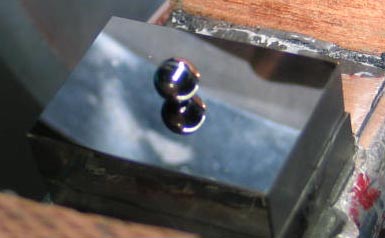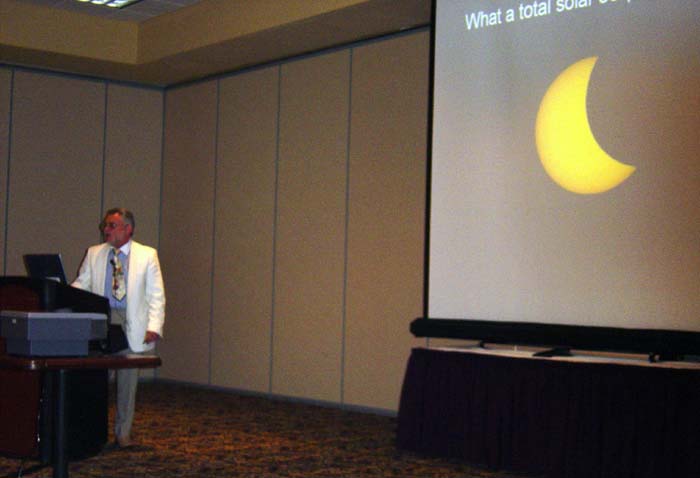

Our Plans for Paraconical Pendulum Research -
using 21st Century Quality Equipment!
We have realized that the application for the pendulum suspension of elements (steel balls and flats) of modern metrological quality, accurate to a hundred nanometers or less, and improvement of the support construction by extrapolation from Allais's experience and stipulations, as well as other modifications such as the use of a lenticular 'Olenici-style' bob which has very low air resistance, make it possible to build a paraconical pendulum at least an order of magnitude more sensitive and accurate than Allais's pendulum was in its day. Moreover, modern electronic sensor technology is easily able to monitor the movement of the pendulum with more than ten times the resolution achieved by Allais, who was necessarily reliant upon simple visual observation. We have also realized (as did Latham in 1980 - see our prior art section) that, if a single pendulum is arranged only to swing in a single azimuth, many of the difficulties of construction and operation become less onerous. If monitoring of pendulum behavior while swinging in multiple azimuths is desired, as it usually is, it is much better to construct multiple pendulums, each mono-azimuthal, rather than using a single pendulum arranged to be successively launched from a variety of initial positions, which was the route that Allais pursued.
Thus, following upon the encouraging reception at the SSE Conference in Las Vegas in May 2004 of presentation of our plans for pursuit of enquiries into the Allais Eclipse Effect.... (Click Here for the home page of the Society for Scientific Exploration)
.... we are proceeding to build several sets of paraconical pendulums, which we intend to install in various different locations around our planet within the next few years. Some of these locations will be chosen close to "hot points" of eclipses, but we are also aware of the importance of performing long-term pendulum researches. In particular, it is a strange but true fact that previous physics research of this nature has always been performed in temperate latitudes above 40o North. Researchers seem never to have considered that perhaps experiments in tropical or equatorial latitudes - or indeed in the Southern hemisphere - might yield unexpected results. Yet if, for example, Dayton Miller's conclusions about the nature of the aether wind have any validity - we are aware that this supposition is a controversial one - then the aetheric dynamical environment below about 25o South latitude may be quite different from that in the Northern hemisphere. It seems worth investigating. A basic set of our "English style" paraconical pendulums consists of four pendulums and associated sensing equipment (cameras, photocells, computers, etc.), and, when deploying one of these sets, our plan is to arrange its four pendulums to swing in four azimuths at 45 degrees to one another, i.e. to set them to swing N-S, NE-SW, E-W, and SE-NW. Each pendulum will therefore be mono-azimuthal - it will be released repeatedly at a single starting azimuth, only ever from one single launch point, and what will be studied will be the variations of its azimuth of swing over time, starting from that starting launch point as a base. We believe that the use of a number of pendulums in this manner will be a great improvement over the experimental procedures adopted by Maurice Allais in the 1950's, because we will primarily consider CHANGES of the amount of precession of each pendulum over time, rather than the actual amounts of precession themselves. In fact, according to this proposed protocol, slight anisotropy of the supports will not actually matter, because we will be studying variations rather than absolute magnitudes. At the moment we have completed the production of three pendulum sets, i.e. of twelve pendulums in all, and we are in the process of distributing them to several groups worldwide and setting them up for observations. And we are embarking upon the manufacture of the next set of twelve. This is not a cheap undertaking, but realistically, over the long term, it will be dwarfed by the costs of observing these pendulums over extended periods of time in various world locations. However the total cost is picayune in terms of the implications: if the Allais Eclipse Effect is real and can be reliably demonstrated on a repeatable basis, the consequences for physics are earth-shaking. There are three basic parts to a paraconical pendulum: the support, the suspension ring, and the bob. The supports of course must be built in situ. We have constructed the rings in the UK, while the lenticular bobs have been cast, machined, and polished in Colombia (the site of the 8 April 2005 eclipse, which will be our first serious solar eclipse observation). You can see detailed manufacturing drawings and a set of pictures documenting the progress of manufacture here - and of course you are welcome to download them and build your own paraconical pendulums - but you would be well advised to consult with us on various details. As for the support construction, the problem is to build a support which will be so massive and solid as to be virtually isotropic. In this connection, the photographs of Allais's support here merit deep consideration: this support proved in practice to be too flimsy. This teaches us that an extremely massive and rigid support structure is required. We are planning two approaches for supporting the pendulums. One is to construct a massive purpose-built "pendulum bunker" from perhaps 30 tons of concrete, semi-buried into the earth. A set of plans for such a structure can be seen here. The other approach is to support the pendulums with an already existing structure, in a well-conceived manner which will be sufficiently rigid. A suitable structure would be an old condemned concrete building. We would mount the pendulums between two floors of the building, i.e. through a concrete floor, with access both above and below that floor required. A mockup or prototype of how this type of pendulum mounting can be performed is shown here. And you can see some movies of this first prototype pendulum swinging in this mocked-up situation by clicking on these links or by downloading the corresponding files. Be warned: they are all from 2.5MB to 4MB in size, so you need either broadband or patience! A closeup of the ball and flat swinging: here A shot of the ring (the "etrier") swinging: here The bob swinging in close-up: here The bob swinging from farther away: here How the ring looks when swinging from below: here The pendulum swinging as a whole (this one is still on its side at the moment!): here Back to the website main page.
